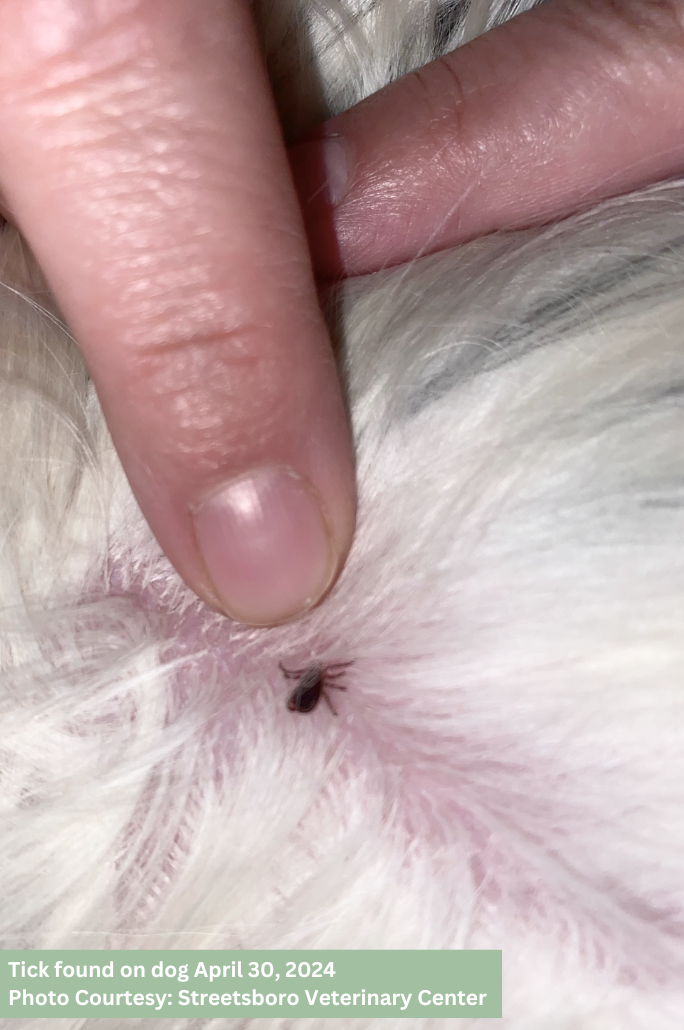 Lyme disease has flown under the radar for far too long. This disease poses a serious health concern to people and pets around the world. As a veterinary practice committed to advocating for preventive healthcare, we believe it is crucial to shed light on this disease to protect your loved ones, human and animal alike.
Lyme disease has flown under the radar for far too long. This disease poses a serious health concern to people and pets around the world. As a veterinary practice committed to advocating for preventive healthcare, we believe it is crucial to shed light on this disease to protect your loved ones, human and animal alike.
Lyme disease is caused by the bacteria Borrelia burgdorferi. A vector, most often the black legged tick which is commonly known as the deer tick, spreads the bacteria between hosts. When a tick finds a host it embeds itself into the dermal layer of the skin to take a blood meal. Embedded ticks go unnoticed because as they attach to the host they inject juices that allow blood to flow freely without pain. Length of attachment is key because likelihood of disease transmission increases the longer the tick is feeding because it is also depositing material back into the host.
 Our dog and cat counterparts have a multitude of efficacious options for preventing Lyme disease. Currently available combination drugs not only target ticks, but also fleas, mites, and other internal parasites including heartworm. These preventive medications are integral to not only protect your pet but all the people that interact with the pet as well. As one of our doctors says "The only good tick is a dead tick". Prescription oral and transdermal medications have the fastest kill times for these parasites limiting the attachment time on a pet. These medications require a prescription as they are regulated and tested by the FDA. Over the counter preventives are monitored by the EPA. They are considered to be pesticides and do not have the same safety or efficacy requirements compared to their prescription counterparts.
Our dog and cat counterparts have a multitude of efficacious options for preventing Lyme disease. Currently available combination drugs not only target ticks, but also fleas, mites, and other internal parasites including heartworm. These preventive medications are integral to not only protect your pet but all the people that interact with the pet as well. As one of our doctors says "The only good tick is a dead tick". Prescription oral and transdermal medications have the fastest kill times for these parasites limiting the attachment time on a pet. These medications require a prescription as they are regulated and tested by the FDA. Over the counter preventives are monitored by the EPA. They are considered to be pesticides and do not have the same safety or efficacy requirements compared to their prescription counterparts.
Dogs have another intervention when it comes to Lyme disease. Vaccination against the bacteria Borrelia burgdorferi, the causative agent in Lyme disease, adds a second layer of protection for your dog. If for some reason prevention was forgotten, spit up without you knowing, or not absorbed properly due to digestive issues, this vaccine provides backup protection to prevent active Lyme disease symptoms. Current vaccination for Lyme disease does not stop the need for monthly ectoparasite prevention. For example: when cars got airbags, we did not stop wearing our seatbelts. Use of one preventive measure does not negate the importance of the other.
Lyme disease can look different depending on how it manifests in a dog. According to Cornell University College of Veterinary Medicine, dogs can display several forms of Lyme disease. Most common presentations include: fever, severe arthritis, swollen lymph nodes, joint swelling, fatigue, or loss of appetite. In serious cases, the kidneys are affected often resulting in death as it is hard to control at this point in the disease process. It is important to know that these symptoms can occur 2-5 months after initial infection and left untreated can lead to chronic joint disease and kidney failure.
If your dog tests positive for exposure to the bacteria that causes Lyme disease, conversation with your veterinarian is crucial. Additional testing results as well as your pet's current health status will determine the next steps. Watching for clinical signs is key when knowing your pet has a positive for exposure to B. burgdorferi. Antibacterial treatments can eliminate an active infection but the remaining damage needs separate intervention that may be lifelong.
 Over the past ten years, the prevalence of dogs testing positive for exposure to B. burgdorferi in Portage County has steadily increased. As published on CAPC, ten years ago the prevalence was under 1% but the incidence is now over 5%. The projected number is upwards of 10% by the end of 2024 for our area. Those numbers may seem really small to some, but the professionals in the fields of parasitology and veterinary medicine are ringing alarm bells. These numbers are limited as they reflect only the dogs tested in veterinary facilities that report their results. The true number is expected to be much higher. You won't find a disease if you are not monitoring for it.
Over the past ten years, the prevalence of dogs testing positive for exposure to B. burgdorferi in Portage County has steadily increased. As published on CAPC, ten years ago the prevalence was under 1% but the incidence is now over 5%. The projected number is upwards of 10% by the end of 2024 for our area. Those numbers may seem really small to some, but the professionals in the fields of parasitology and veterinary medicine are ringing alarm bells. These numbers are limited as they reflect only the dogs tested in veterinary facilities that report their results. The true number is expected to be much higher. You won't find a disease if you are not monitoring for it.
 The graphics illustrate this change. As of Spring 2024, Ohio is sitting at a 5.4% prevalence in dogs testing positive compared to 0.7% in 2014.
The graphics illustrate this change. As of Spring 2024, Ohio is sitting at a 5.4% prevalence in dogs testing positive compared to 0.7% in 2014.
As part of our preventive medicine protocol, our practice requires a heartworm and tick borne disease test once a year. Because ticks are now endemic to our area, screening for exposure is key. The tests we use identifies exposure to the following tick borne diseases: Lyme, Ehrlichia, and Anaplasmosis. With Lyme disease being a significant threat to both humans and animals, education and preventive measures are the best way to reduce the chance of exposure to you and your loved ones. Unfortunately for humans, there are no FDA approved preventions to kill ticks, which inhibits Lyme disease spread. Although historically available, there is not an approved Lyme vaccine for humans at this time. As of 2024, the CDC reports clinical trials are in progress for a human Lyme vaccine. Let's keep our fingers crossed!
 If you are interested in learning more about Lyme disease in humans the CDC has an informational brochure. If you or a loved one are concerned about exposure to Lyme disease, please contact your human healthcare provider. This blog just scratches the surface so please reach out to one of our veterinary clinics by giving us a call or schedule an appointment if you have questions about Lyme disease, prevention options, or vaccine availability. At the end of the day, Lyme disease is common, it is spreading, and it is preventable.
If you are interested in learning more about Lyme disease in humans the CDC has an informational brochure. If you or a loved one are concerned about exposure to Lyme disease, please contact your human healthcare provider. This blog just scratches the surface so please reach out to one of our veterinary clinics by giving us a call or schedule an appointment if you have questions about Lyme disease, prevention options, or vaccine availability. At the end of the day, Lyme disease is common, it is spreading, and it is preventable.
